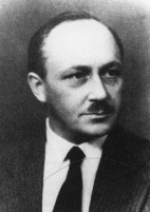Erich Kettelhut
| Erich Kettelhut | |
|---|---|
 |
|
| Born |
Erich Karl Heinrich Kettelhut 1 November 1893 Berlin, Germany |
| Died | 13 March 1979 (aged 86) Hamburg, West Germany |
| Occupation |
Production designer Art director Set decorator |
| Years active | 1919–1960 |
Erich Karl Heinrich Kettelhut (1 November 1893 – 13 March 1979) was a German production designer, art director and set decorator. Kettelhut is considered as one of the most important artists in the history of early German cinema, mainly for his set direction for Die Nibelungen (1924) and his design and visual effects for Metropolis (1927). His early career was defined by a working relationship with fellow designers Otto Hunte and Karl Vollbrecht, the trio working on many of Fritz Lang's early German films. Despite being best known for his iconic visuals on several of the most important films of German Expressionist cinema, he is also noted for a career spanning into the 1960s and his work on more light-hearted films and musicals.
Kettelhut was born in Berlin in 1893. After leaving school, he received training at a craft school as a theatre artist. In 1909 he first met Otto Hunte, when they were placed in charge of art direction at the Aachen's Stadttheater. The two became long-time collaborators during their early cinema careers. From 1910 until 1912 Kettelhut studied at the College of Applied Arts in Berlin. This was followed by time spent as an apprentice in local theatres around Germany including a period as a scene painter at the Metropolitan Opera in Berlin and a role as the head of the design department in Mühlhausen. His role in theatre was interrupted when Kettelhut was called to serve at the Front in 1914. After being discharged at the end of the First World War his old colleagues, Hunte and Karl Vollbrecht, found Kettelhut employment at Martin Jacoby-Boy's design agency in Berlin. One of the firm's clients was MayFilms, the production company for film maker Joe May and was through these ties that Kettelhut first began his work within cinema.
Kettelhut was first employed in cinema for May Film's 1919 production Die Herrin der Welt (The Mistress of the World), an eight-part epic of German cinema. Kettelhut was employed as a production designer on all eight parts and is also credited as a set decorator on the first part. It is on this film that he was re-united with Otto Hunte, to whom he worked as an assistant, and Karl Vollbrecht, both of whom would work on many films with Kettelhut in the future. Also employed on The Mistress of the World, but as a writer was Fritz Lang. Kettelhut worked as an assistant to Jacoby-Boy on two further pictures in 1920, the first being Das wandernde Bild (The Moving Image), in which Kettelhut was first introduced to Lang who was directing the film. After producing designs on both parts of 1921's The Indian Tomb, Kettelhut was hired to work on Lang's Dr. Mabuse the Gambler (1922), he was again teamed with Hunte and Vollbrecht.
...
Wikipedia
